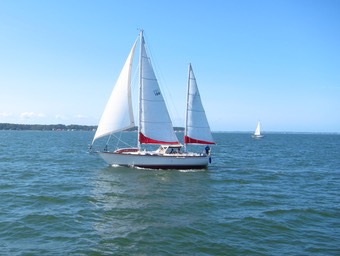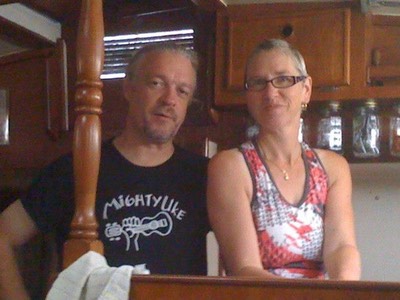Travel 2018-2019
Equinox Cruise
Sailing is all about cooperation. Nothing happens in isolation. The progress of a sailboat through the water requires wind, for example. There are other examples of cooperation, we’ll get to them.
The Equinox cruise was timed to greet the passing of the sun over the horizon on September 22nd, 2018 at 21:54 EDT. We celebrated the end of summer in Dunn’s Cove, off Harris Creek on the east side of Tilghman island.

Susan signed on as crew, and brought mountains of food. By itself, this is a wonderful example of cooperation. But it gets better.
The weather Saturday was spectacular for a big, heavy cruising boat like Red Ranger. We had winds from 10 to 15 knots, with a rare gust to 20. The early-morning seas were relatively flat. With wind from almost due north, we could comfortably broad reach across the Bay.
Rather than go through Knapp’s Narrows, we went south around Back Walnut Point. The turn into the Choptank river always involves a huge question. “Will the wind on the other side of Tilghman cooperate as well as the wind in the Bay?”
With only two on board, tacking the huge Yankee is difficult. With an extra hand, we were able to beat up the Choptank through several tacks. Cooperative sail handling is one of the best parts of sailing. There’s a profound joy in the essential cooperation required to call “Ready about?” and “Helm’s a-lee!”

Red Ranger’s cutter rig worked out well when we switched from the giant yankee down to the inner stays’l. We could then do our version of short tacking up the Choptank. The history is truncated by Marine Traffic. I think this is because we vanished from coverage. The last point recorded properly was at 17:57 UTC (1:54 EST). We made one more tack before firing up the engine to wind through the marks in Harris Creek.
We rafted up with Cephas Dawson. Our 25 Kg Rocna held both boats comfortably through drinks and snacks and story-telling. There’s a whole host of cooperation involved in rafting up, and shipping drinks from one deck to the other deck.
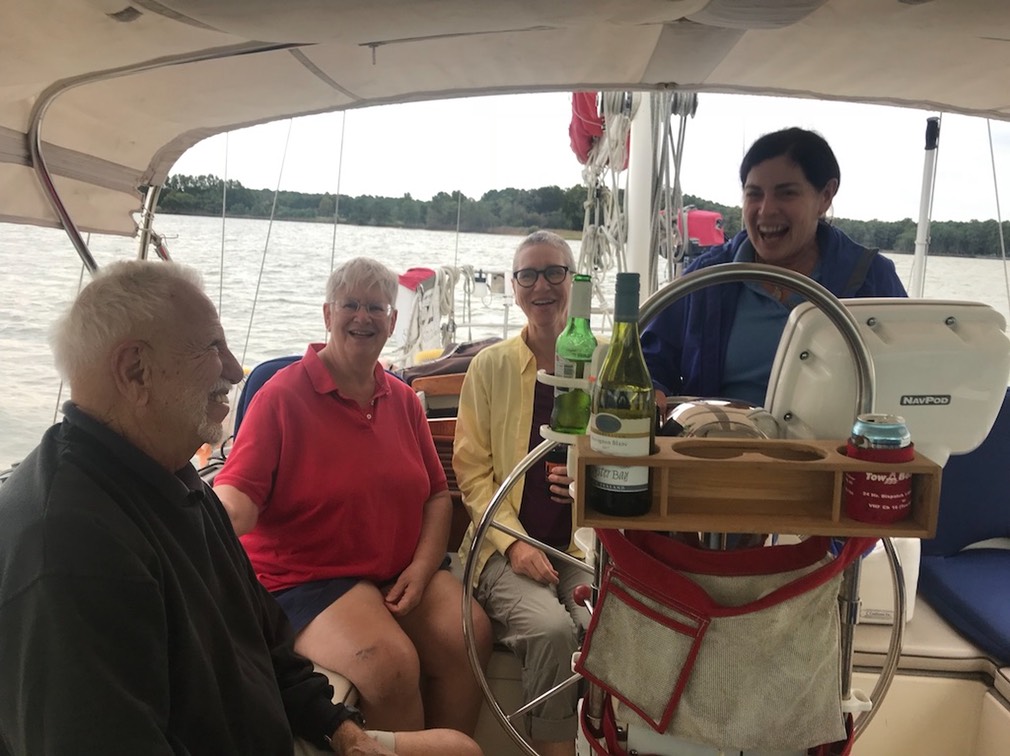

Red Ranger’s cockpit is large. However, getting over the winches to get into the cockpit isn’t always easy. It takes a deal of cooperation from everyone involved to make sure the guests arrive safely and can find ways to be comfortable.
The moon peeked through the clouds to see what we were doing. The night was calm. Until it started to rain.
It was a quiet, gentle rain. But thoroughly soaking. And it thoroughly soaked us all day Sunday. Here’s a view of Red Ranger during a brief gap in the showers.
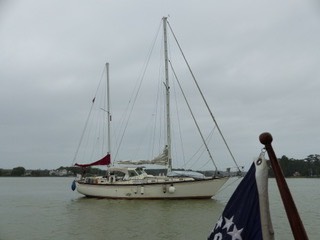
Besides tacking, another joy of having a cooperative, skilled crew is getting a hot breakfast. (Thanks Susan!) We spent Sunday morning rolling across the two-to-three foot seas and 10 to 15 knot winds with driving rain. It may have been a good sailing day, but we motored through the wet.
Here’s a picture of another guest on Red Ranger.
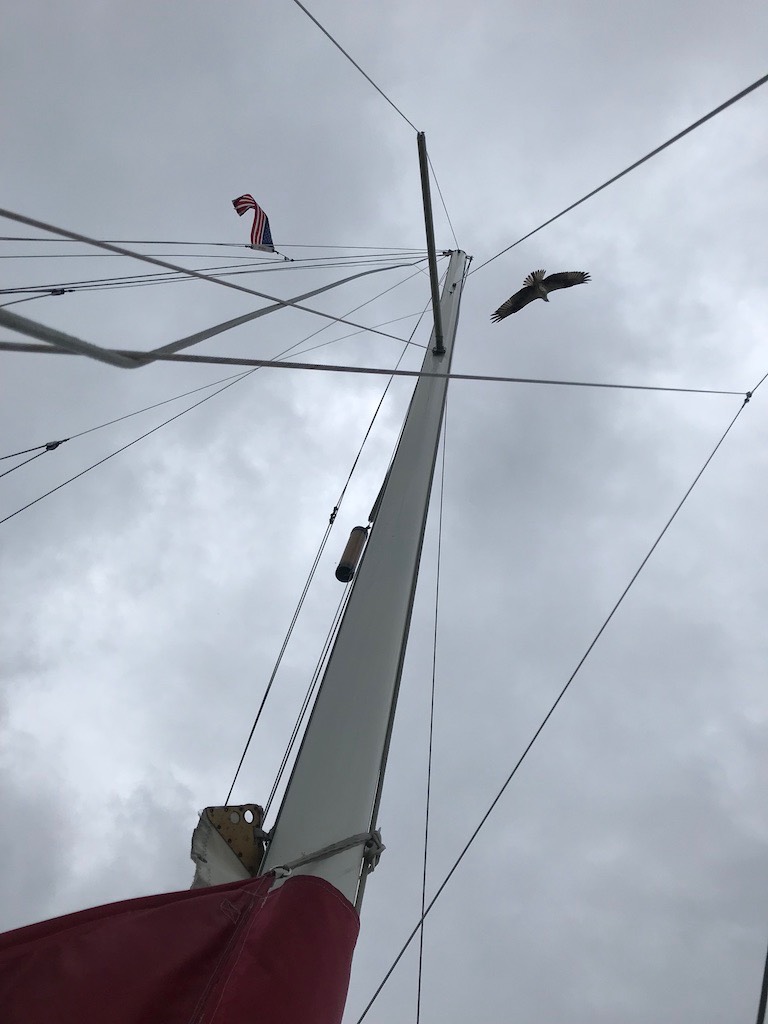
This was an Osprey with a fish, looking for a place to settle down and enjoy a meal. It tried the top of the mizzen mast a few times, but didn’t stay with us.
The secret to a great Equinox Cruise is cooperation. While cooperative weather might have been nice, having a cooperative crew and fellow sailors is always the best way to spend a weekend.
Hurricane Florence
We’re lucky. As of Thursday (when Florence made landfall) the projected course was well away from the Chesapeake bay. There will be Tropical Depression wind and rain, but not a direct hit, and — hopefully — minimal storm surge.
Here’s Red Ranger’s hurricane preparation list:
- Remove foresails. The furling line can break and the sails unfurl destructively. Some marinas won’t haul with headsails in place.
- Tie up main and mizzen. We use a long line to wrap up the sails and sail covers with a technique called “Swedish Furling.”
- Stow floaty ball. We don’t need the anchor marker float on deck.
- Deflate and stow Scout. We don’t need the dinghy on deck.
- (optional) Stow jerry cans. These don’t provide too much windage. They’re heavy. They can be put into the cockpit.
- Stow fenders. Either use them or put them below.
- Take down the Bimini. The fabric will flog itself to death.
- Close the galley hatch. With the bimini gone, it will let rain in.
- (optional) Double up lines with chafe guards. We have large (at least ⅝” perhaps ¾”) dock lines that utterly fill each cleat. It’s hard to find anything else to use for ducklings. Winches, maybe.
- Use extra line to tie down the anchors. They’re secured with a number of small lines, a few extra bits of line won’t hurt.
And now we’re going to wait until the 18th of September before we undo everything. The storm’s track involves a potential for some fearsome winds in the beginning of next week.
Rainy Weekend
May as well clean.
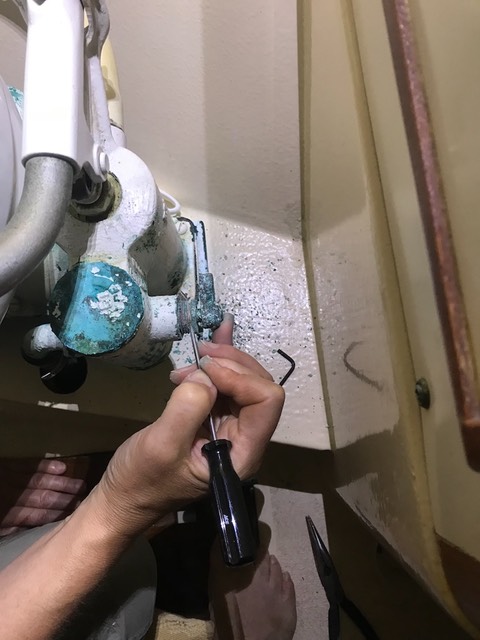
And fix things.
This thing is the pump assembly on our Marine Sanitation Device (MSD). You might know it as a toilet.
CA’s picking the paint out of the inlet valve packing nut.
The forward cylinder (with the greenish top) is raw water used for flushing. The rearward cylinder (with the lever) is the waste pump.
The water wasn’t going in to the MSD to flush. The packing nut was spinning when the foot pedal was operated.
What’s supposed to happen is a cam rod going through the packing nut turns to open and close the water valve. But it wasn’t. The whole packing nut was turning. And slowly unscrewing itself. So water wasn’t going in.
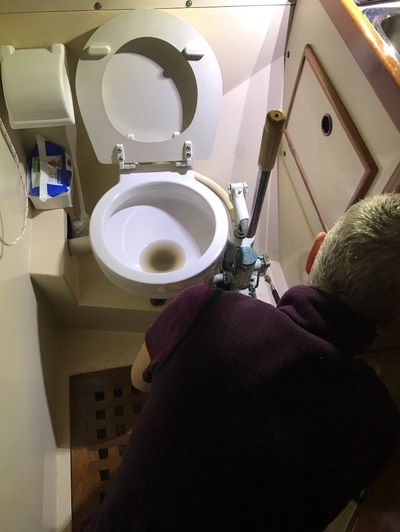
Which lead to a volcano of shit (“shitcano”).
Now. Fixed.
“Eeew,” you say. “The water’s brown.”
“Correct,” we respond. “The creek is very turbid. The MSD flushes with raw water, and it’s brown when there’s been a lot of rain."
Next job?
Pump some of the fluid out of the center tank to confirm it really is full to the top with diesel.
And it is. Each time it sloshes around, some diesel comes out. I guess I’ll pump a few gallons out each time we’re on the boat until it stops coming up diesel.
Then?
Hurricane prep. Florence is coming and — if it’s going to hit the upper bay — the headsails need to come down and the mail needs some extra lashing. We’ll relocate the fuel jerry jugs to the cockpit to reduce windage. And maybe lash down scout with some extra line to make sure it stays on deck.
Labor Day Outing
Last year, we — sort of — lead a cruise for Labor Day. We learned about Dog-Stopping. This year, we learned a little more about racing and light-air sail handling.
This year, we decided to participate in the Annual Billy Heinz Regatta at WRSC.
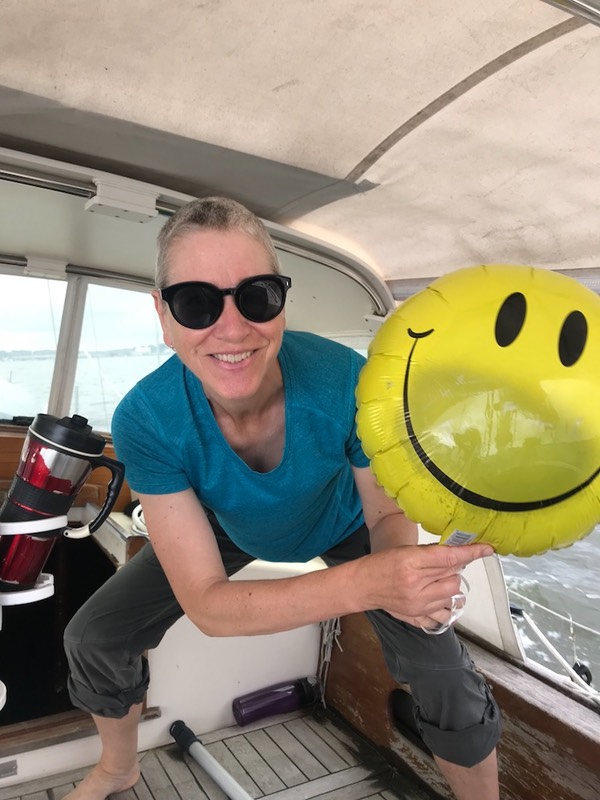
We left the dock just a hair too late on Saturday to be part of the committee boats.
We did, however, bag one of arch-enemies: a mylar balloon. We hates them all, precious, we curses them.
They’re a pernicious bit of trash because they also waste helium, which has better purposes than kids toys that turn into litter a/k/a an environmental hazard.
I was able to help out on Sunday. And watch some fine racing among three very competitive fleets. They used fairly complex triangle course requiring three of the large marks and two of the small marks to lay out the triangle itself, plus the start and finish gates.
Race committee is a fun day on the water.
While we motored up on Saturday, we tried to sail back on Monday.

I’ve been working on sail trim for our kind of ketch. There’s a lot going on that I still don’t quite get. I’m doing better, but…
Monday the wind was 4-5 kt at most. It was from the SE, and more-or-less on our nose, forcing us to tack our way down the bay.
However.
Our close-hauled angle is bad. It’s about 60°, which is crazy far off the wind. And we can only get that close to the wind by pushing the bow up with a substantial amount of helm.
Ideally, a sailboat has “weather” helm. It will tend to round up into the wind unless you steer away from the wind. The normal behavior should be to “pinch."
So far, my light-air setup gives Red Ranger “lee” helm. Which means the yankee is overpowering the mains’l. This seems to mean that I need to reef the yankee when we’re beating in light air. I’ve got to experiment some more to locate an ideal reefing position.
The other possibility is to try and use the mizzen to point us higher. The problem — I think — with beating to windward with the mizzen and the main is dirty air from the main disrupts doesn’t create a useful flow over the mizzen.
More to learn! Yay!
